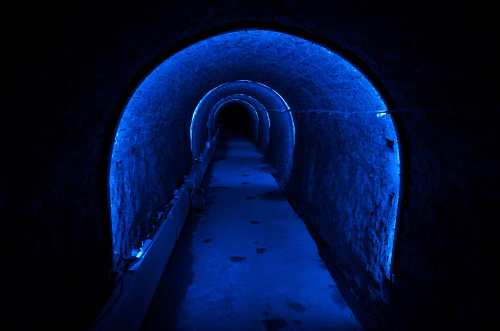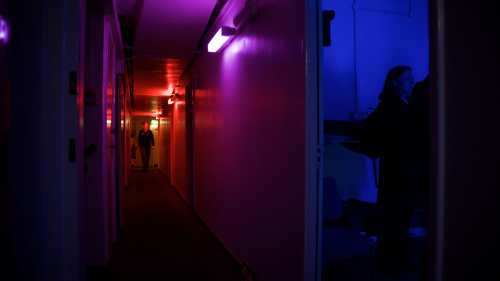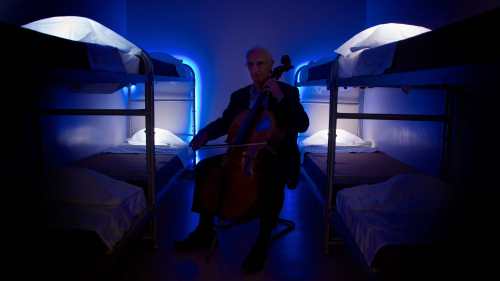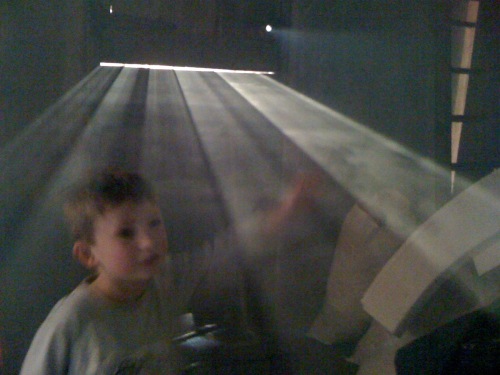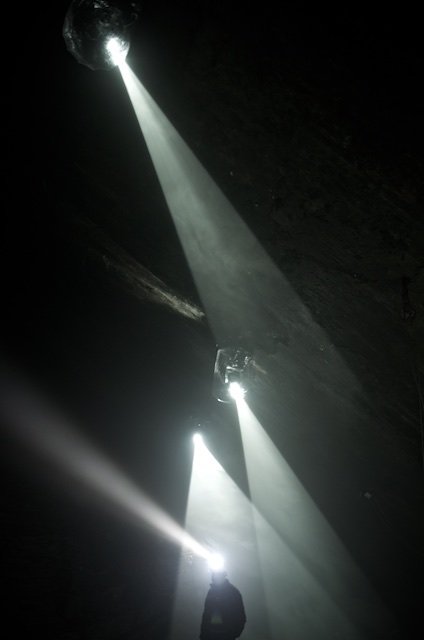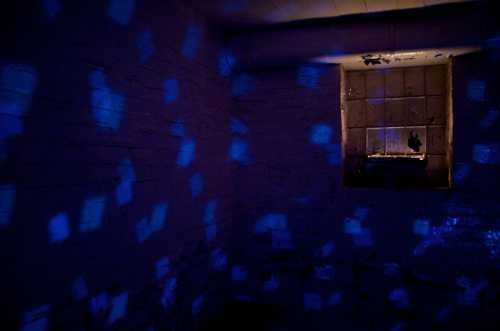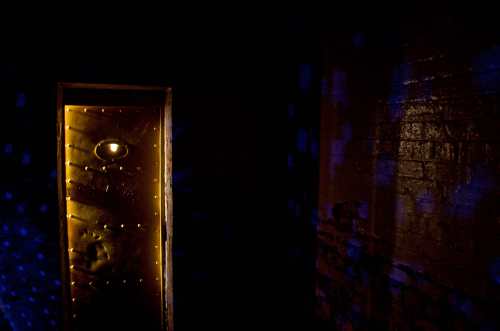Jean-Michel Jarre has a new album out.
OK. I’ve got to start a blog post somewhere and it’s been a while since the last one so be gentle on me.
But really. Jean-Michel does have a new album out. Predictably it’s all big synthesizers and arpeggios, only this time it’s collaborating with other big synthy people, like Tangerine Dream and Vince Clark and Moby and … er… Lang Lang.. Still, it’s predictably Jarre enough for me today.
Jarre at his best is a serious musician writing big, complex compositions using electronic synthesised instruments. Hugely prolific – having recorded over 20 albums since 1972 and influenced generations of electronic musicians – he’s kind of the Mozart of electronic music. And like Mozart, he’s quite partial to a tune or two.
In the 80’s he famously transformed his concerts into huge outdoor spectacles of light and sound. I’ve written about these in a previous post (a long time ago). For me, the transformation of city skylines as a backdrop for music has always fascinated me.
— — —
Last year I embarked on a collaborative project with one of the orchestras I play with to create artworks of music and light in underground spaces. The Cobweb Orchestra is an amateur organisation that allows musician of any instrument and ability the opportunity to come together and play in an orchestra. There’s a number of regular weekly groups across the north of England and the project wanted to do something that united the whole membership and explore the region. And what unites the region is the heritage of going underground. Be that mining or shelter or transportation. So the Underground Orchestra project was born to play the music of the north deep within the land of the north. An orchestra playing underground is interesting and unusual. but an orchestra playing inside a light installation underground would be amazing and unique.
The difficulty comes with doing something that relates to both the location and the music, but doesn’t over power either. I wanted to do something that wasn’t stage lighting or lighting design, but could stand alone as an installation in its own right, yet became something again when combined with an orchestra.
— — —
Long before Jean-Michel Jarre there was Thomas Wilfred.
Wilfred was born in Denmark in 1889. As a teenage he moved to New York and began experimenting with light as an artform. In 1919 he created his first ‘Clavilux’. A machine which through the use of mirrors and coloured glass, performed symphonies of light. Each composition was contained on a glass master disk so that in theory a machine could play different pieces. In reality, the machines were very different – each more advanced and complex. Opus 2 had its first public performance in 1922 to huge critical acclaim. In the audience that night was Leopold Stokowski – but more of him later.
As purely analogue machines, the compositions have a quality and presence that I fear is somewhat lost on Youtube. The machines themselves included curved screens behind curved glass creating a unique three-dimensional effect. Wilfred was adamant that his light compositions were not filmed – he saw the quality of light as a distinct artistic medium – so the only compositions that remain are with the 30 surviving Clavilux machines.
The quality of light and colour perception is a main component of James Turrell‘s work too.
 ‘Breathing Light’ – James Turrell 2013
‘Breathing Light’ – James Turrell 2013
I think it’s difficult to work with light and colour and not be influenced in some way by Turrell’s mastery of the medium, although recently Drake’s music video for ‘Hotline Bling’ might have come a bit too influenced..
The conductor Leopold Stokowski was particularly interested in the relationship between light and music. One of the more colourful characters of classical music, Stokowski was a bit of a showman. He’d famously throw scores onto the floor if he knew the music well enough. He also dismissed with the baton entirely, instead preferring exaggerated gestures using both hands to conduct the orchestra. In some of his more extravagant experiments he would plunge the orchestra and theatre into total darkness with only a light on his white gloves. On another occasion he spotlighted himself to cast a shadow of his movements above the orchestra. However, Stokowski’s main claim to fame is his legendary appearance in Disney’s ‘Fantasia‘. The opening sequence and Bach’s Toccata and Fugue are pure genius:
The great things about underground spaces is they are dark. really dark. The kind of dark where you genuinely can’t see your hand in front of your face. This means that whatever light you use, it’s pretty much going to be the only light. Of course there are issues that with an orchestra, the musicians are likely to want to see their music, which means some white light. But if you make a feature of that light rather than try to hide it, even the reading lights become part of the visual and part of the environment.
The first venue in October last year was the ‘Victoria Tunnel’ beneath Newcastle. The Victoria Tunnel was built to transport coal from the mines to boats on the river Tyne and runs right underneath the centre of the city of Newcastle. I wrote more about it last year. As the first of the events I was keen to find a voice for the future events. Somewhere between Turrell and ‘Fantasia’ is what I had in mind. Using mono-frequency lights to give me a saturated blue light to accentuate the Purkinje effect – the way things tend to look bluer under very low light levels and the way moonlight seems to be devoid of colour. By using LED lights I could strip away the rest of the spectrum as it just wouldn’t exist beyond the 465nm wavelength. It’s technical, and you don’t need to understand how it works, but when you’re in it it’s very different to seeing photos of it.
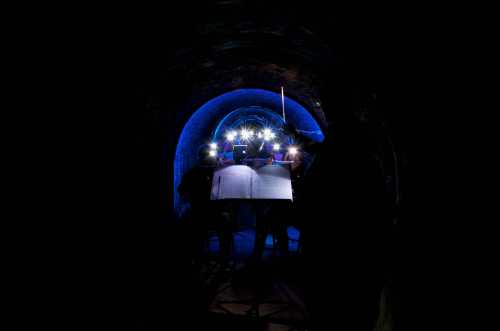
The Cobweb Orchestra performing Michael Betteridge’s ‘From Mine to Tyne’ in the Victoria Tunnel beneath Newcastle upon Tyne. 22nd October 2014
The main challenge of the tunnel was the listed nature of the structure itself. This meant that I couldn’t physically attach anything to the walls. So instead I had to devise a way of keeping the lights in place purely by springing them against the walls using carbon fibre rods.
The restrictions were amplified at the next venue – the York Cold War Bunker. Built to monitor fall-out levels in the event of a nuclear attack the site oozes with the cold, steely fear of ‘the bomb’.
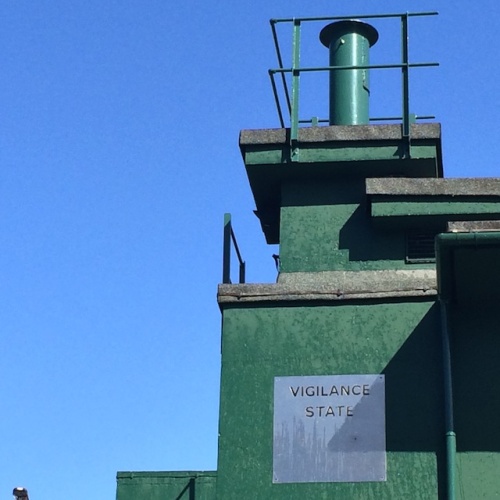
As an English Heritage site, every last detail was listed. The very fabric of the building and every layer of paint on its surface had to be conserved. The solution to this was to filter the existing lights to create bodies of colour to set moods and define space.
With such little time to install and so many rooms to transform, everything had to be as simple as possible. Still continuing the Turrell / Disney inspiration, each room had its own character. The depth of colour and its changes through the building added to the unsettling atmosphere of this Cold war relic.
In the women’s dormitory I used the same blue light as the tunnel, but added sound responsive white lights. The normally dormant pillows would progressively wake and glow in response to the volume of the music being played in that room.
The third location – the Cleveland Ironstone Mining Museum presented its own challenges. Again the prime factors were the number of spaces (three) and the relatively short install time. One of the spaces was a drift mine shaft – a brick-lined tunnel sloping down into the ground about 80 metres long. There was enough space for three musicians to play at the bottom. However, there was a limit to the number of people who could be in the tunnel at any one time. I somehow needed to convey what was being played to an audience who may not even be in the tunnel.
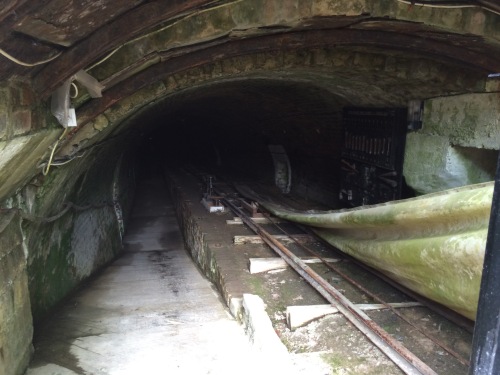
the drift mine entrance
For this I looked to Wilfred and his use of light as music. As it was a trio performing I figured they could be represented by the three primary colours of white light – red, green and blue. With each instrument linked to their own colour, the resulting projection would constantly change colour in direct response to the playing.
The next location was always going to be the centrepiece of the project. A full-sized symphony orchestra playing inside an iconic Lake District mountain. The space was vast – an old slate mine cavern deep within Fleetwith Pike at Honister. This would be the biggest orchestra of the project and at 80 – 90 people, the largest single underground audience. What was needed here was something on an equally grand scale.

Honister Slate Mine above Honister Pass in the Lake District, UK
A few years ago, when my studio was in a drafty barn on Stainmore, I was playing with smoke machines for a piece on the gothic decay of light in the clouds for a conference in Lancaster. This meant filling the studio with smoke to test the piece. At the end of the day as the sun was setting, my eldest came to see what I was up to and ended up playing in the shafts of light as they came through the gaps in the barn doors.
It’s all so very Anthony McCall, but I liked the way you could see on top and underneath these shards of light. They had a real presence to them.
For the piece in Honister Mine I wanted to recreate those thin slices of light through the air – big flat, sharp slices in the way that slate is sliced cleanly down the grain.
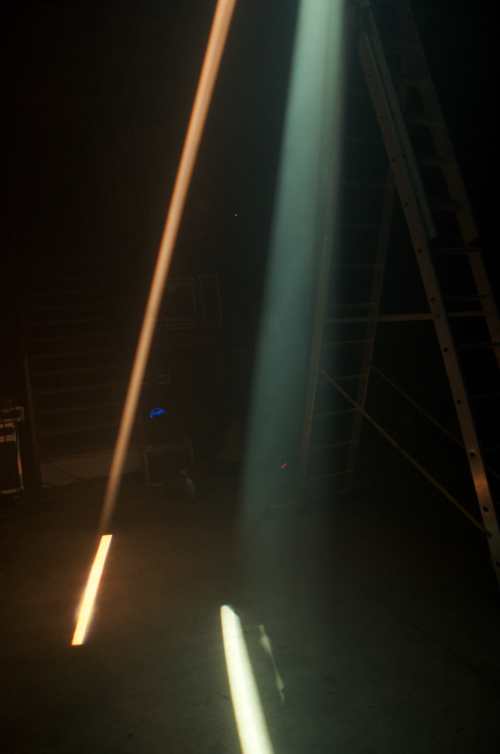
testing the shards of light in a warehouse in Gateshead
‘Rive’ took weeks of development and testing to find the right light source for the right quality of light and the right sharpness of its edges. the installation inside the cavern alone took over a week.
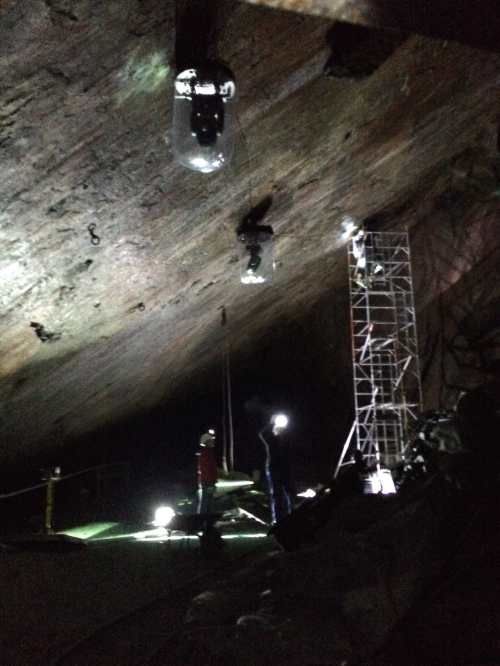
Installing ‘Rive’ in Honister Slate Mine
The final piece was a series of thin shafts of light from the roof of the cavern to the floor. they had a solid, sculptural quality – you could look all around them and clearly see their edges, yet you could walk straight through them as if they were an apparition. Again this was a real experiential piece. No number of pictures or video really does them justice.
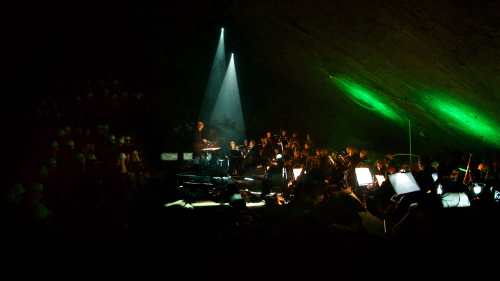
By contrast, the final venue last week, was by far the smallest and most intimate. A single prison cell beneath the former town hall in Wallsend. THis was a very simple affair with musicians playing short 20 minute sets with room for no more than four players at a time. The cell door was kept closed and the audience could hear the music throughout the basement but could only see the players through the spyhole in the steel reinforced door.
The Underground Orchestra was no Jean-Michel Jarre experience. But neither did it want to be. These were small-scale performances in mostly very small-scale spaces. But was interesting was looking at the relationship between music, musicians, light, scale and location. The music was a key element – a wonderful programme of music from the Northern counties – historical and contemporary. Beyond being an investigation of the cultural heritage of the north, for me this was as much about exploring the landscapes that I live within.
There are many sides to landscapes. The underneath one was fun.
